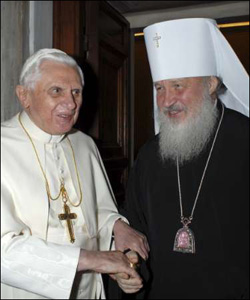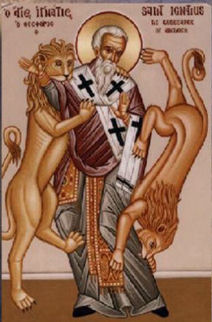In a previous post we discussed Derrida's claim that an adequate translation can only be made when we understand not only the grammar and vocabulary of a language, but also the rhetorical uses of the language, as well as the history and the cultural context of work. With this in mind, we return to Marion, whose explication of the Eucharistic site of theology and the role of the (Roman Catholic) bishop as true theologian and mediator of Christ is also situated within a given context.
Robyn Horner writes that the context of Marion's claim includes a papal visit to France,[1] but looking more broadly at the Roman Catholic context that many of Marion's readers lack we find an enlightening moment:
"Christians come together in one place for the Eucharistic assembly. At its head is Christ himself, the principal agent of the Eucharist. He is high priest of the New Covenant; it is he himself who presides invisibly over every Eucharistic celebration. It is in representing him that the bishop or priest acting in the person of Christ the head (in persona Christi capitis) presides over the assembly, speaks after the readings, receives the offerings, and says the Eucharistic Prayer." (from Catechism of the Catholic Church) [2]
It is to the advent of the bishop within the iterations of the text that we now turn.
The first mentions of a bishop (from the Greek word episkopos whose secular meaning translates as "overseer" or "guardian" before the Christian context imbued it with new connotations) appear in the New Testament texts of Acts 20:28, Philippians 1:1, and 1 Peter 2:25. These earliest references lack the connotation of an office that will be found in subsequent biblical texts.
In 1 Peter, the bishop in question is Jesus Christ himself, the reference having more to do with the function of guardian than a hierarchical role, while in the Acts reference, a speech that "Luke" attributes to Paul, addresses bishops who are synonymous with the elders (presbyteroi) of the church at Ephesus mentioned in 20:17. Within a short period the meanings of these two words began to differentiate as presbyters became synonymous with the priestly office in the church (a new semantic meaning added to the original meaning of "elder").
The Ephesian church's abundance of bishops contrasts with the hierarchical structures that will emerge in the next century where one bishop to a church becomes the norm. Paul's salutation to the Philippian church follows this same pattern, greeting several bishops within the congregation.
Later references to the bishop within the pseudo-Pauline corpus (1 Timothy 3:2; Titus 1:7) begin to take on an official character with a specific list of prerequisites for the job. However, none of these texts are tied directly to the Eucharist.
A firm link between the role of the bishop and the Eucharist appears in the writings of Ignatius of Antioch, the third bishop of his local church (following the apostle John and Polycarp).
Martyred around 108 CE, Ignatius wrote a series of letters to the churches of his region as he traveled to Rome.
A common theme of several of the letters concerns the practice of the Eucharist. To the church at Ephesus, he sent exhortations to obey the bishop and their priests, breaking one bread together.[3]
But in his letter to the church at Smyrna, he was explicit:
"Nobody must do anything that has to do with the Church without the bishop's approval. You should regard that Eucharist as valid which is celebrated[4] either by the bishop or by someone he authorizes. Where the bishop is present, there let the congregation gather, just as where Jesus Christ is, there is the Catholic Church." [5]
Finally, in his letter to the church at Philadelphia he urges the congregation to avoid an apparent schism in which Jewish Christians were practicing the Eucharist on Saturday instead of at the already customary Sunday service:
"Be careful, then, to observe a single Eucharist. For there is one flesh of our Lord, Jesus Christ, and one cup of his blood that makes us one, and one altar, just as there is one bishop along with the presbytery and the deacons, my fellow slaves." [6]
 These passages become the basis for understanding the role of the bishop in the early church that carries forward in both Roman Catholicism and Eastern Orthodoxy.
These passages become the basis for understanding the role of the bishop in the early church that carries forward in both Roman Catholicism and Eastern Orthodoxy.
But in our next post we will trace a textual chain that takes the Western church down a path radically divergent from the churches of the East, setting the scene for a Eucharist whose celebration requires a male celebrant.
[1] Horner, Jean-Luc Marion: A Theo-logical Introduction: 10.
[2] Part 2 Section 2 Chapter 1 Article 3.IV.1348
[3] Letter to the Ephesians XX.
[4] By the time of Justin Martyr's First Apology (ca. 150 CE), another interesting mark appears in the liturgical tradition appears: After the congregation has offered prayers and greeted one another with a kiss, "[t]here is then brought to the president of the brethren (proestōtitōn adelphōn) bread and a cup of wine mixed with water" (First Apology). This first reference to the "president of the brethren" appears to provide the ground for the celebrant of the Eucharist to mutate into the presider over the Eucharist in the Western tradition.
[5] Letter to the Smyrnaeans VIII.
[6] Letter to the Philadelphians IV, emphasis added.




